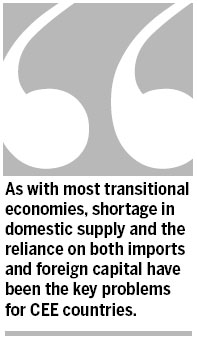
Central and East European economies are an attractive destination for Chinese companies keen to 'go out'
Central and East European nations have experienced comprehensive transformation since the late 1980s, characterized by privatization, deregulation and marketization, and the implementation of stabilization policies and political democratization.
Rapid economic growth has been attained in CEE countries particularly since their accession to the European Union and the per capita GDP in a number of CEE countries has risen to over $10,000. The International Monetary Fund has categorized Slovenia, Slovakia and Estonia, all members of the eurozone, as advanced economies.
But the economic development of CEE countries since their transition has been imbalanced and it has relied significantly on investments from West and North European countries. The macroeconomic structure of many CEE countries is characterized by a high rate of growth together with a high level of external debt. There are substantial weaknesses in the economic growth of CEE countries, despite their economic accomplishments.
The fragility of CEE economies has been fully exposed by the global financial crisis and the eurozone sovereign debt crisis, as demonstrated by their high current account deficit, high rate of unemployment and high level of external debt. The intrinsic weaknesses of the CEE countries have been magnified by the effects of the crises so that these countries are subject to the pressure of fiscal and budgetary difficulties.
In addition, as CEE countries have been securing financing from the global capital markets, they are under the pressure of debt financing and are thus subject to their own sovereign debt crises. CEE countries are caught between choosing expansionary policies to stimulate their economies and subsidize the unemployed in order to ensure social stability, or implementing policies to alleviate debt pressure.
Considering the macroeconomic situation, receiving investments from Chinese enterprises is an applicable and effective method for CEE countries to tackle the economic downturn. On the one hand, investments from Chinese enterprises are conducive to the reduction of debt volume; on the other hand, the investing activities of Chinese entities in CEE markets can stimulate their economies and boost employment.
In recent years, Chinese enterprises have started to orient their investments to overseas economies and have undertaken a considerable number of mergers and acquisitions overseas. This is an inevitable choice for Chinese businesses that have accumulated substantial capital as the domestic market has gradually become saturated. The pace of overseas investment has accelerated in recent years as the central government began to advocate that national businesses "go out" into the global arena.
Compared to investments from developed countries, investments from China are characterized by low-cost labor-intensive manufacturing industries. Such investment projects suit CEE markets as they are using either localized or small-scale technology.
In addition, direct investment to CEE countries is conducive to the amelioration of the deficit in Sino-CEE trade, since traditionally exported products can be manufactured in the local countries. Thus Sino-CEE trade should be encouraged as intra-regional trade under the common market architecture of the EU.
Sino-CEE economic ties have deepened in recent years as both China and CEE countries have accomplished rapid economic growth. The bilateral trade volume has risen significantly in recent years and China has become one of major importers and sources of foreign investment for CEE countries. There is plenty of potential for bilateral trade and investment still to be tapped. Agriculture, mining, mechanical industry, electronics, home appliance, automobiles, telecommunications, aviation and infrastructure construction are attractive investment projects for Chinese businesses.
CEE countries should implement preferential investment policies to attract Chinese investment. Meanwhile, it is also a historical opportunity for Chinese businesses to "go out".
The author is an assistant professor at the Institute of Russian, East European and Central Asian Studies at the Chinese Academy of Social Sciences.
(China Daily 04/26/2012 page8)